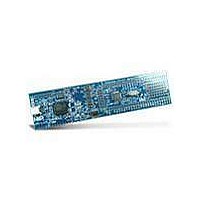OM11049,598 NXP Semiconductors, OM11049,598 Datasheet - Page 28

OM11049,598
Manufacturer Part Number
OM11049,598
Description
MCU, MPU & DSP Development Tools LPC1114 Demo Boards Cortex M0
Manufacturer
NXP Semiconductors
Datasheet
1.OM11049598.pdf
(66 pages)
Specifications of OM11049,598
Processor To Be Evaluated
LPC1114
Processor Series
LPC11xx
Interface Type
I2C, SPI
Maximum Operating Temperature
+ 85 C
Minimum Operating Temperature
- 40 C
Operating Supply Voltage
3.3 V
Tool Type
Demonstration Board
Core Architecture
ARM
Cpu Core
ARM Cortex M0
Data Bus Width
32 bit
Lead Free Status / RoHS Status
Lead free / RoHS Compliant
NXP Semiconductors
LPC1111_12_13_14
Product data sheet
7.15.5.1 Power profiles (LPC1100L series, LPC111x/102/202/302 only)
7.15.5.2 Sleep mode
7.15.5.3 Deep-sleep mode
7.15.5.4 Deep power-down mode
peripherals, allowing fine tuning of power consumption by eliminating all dynamic power
use in any peripherals that are not required for the application. Selected peripherals have
their own clock divider which provides even better power control.
The power consumption in Active and Sleep modes can be optimized for the application
through simple calls to the power profile. The power configuration routine configures the
LPC1111/12/13/14 for one of the following power modes:
In addition, the power profile includes routines to select the optimal PLL settings for a
given system clock and PLL input clock.
When Sleep mode is entered, the clock to the core is stopped. Resumption from the Sleep
mode does not need any special sequence but re-enabling the clock to the ARM core.
In Sleep mode, execution of instructions is suspended until either a reset or interrupt
occurs. Peripheral functions continue operation during Sleep mode and may generate
interrupts to cause the processor to resume execution. Sleep mode eliminates dynamic
power used by the processor itself, memory systems and related controllers, and internal
buses.
In Deep-sleep mode, the chip is in Sleep mode, and in addition all analog blocks are shut
down. As an exception, the user has the option to keep the watchdog oscillator and the
BOD circuit running for self-timed wake-up and BOD protection. Deep-sleep mode allows
for additional power savings.
Up to 13 pins total serve as external wake-up pins to the start logic to wake up the chip
from Deep-sleep mode.
Unless the watchdog oscillator is selected to run in Deep-sleep mode, the clock source
should be switched to IRC before entering Deep-sleep mode, because the IRC can be
switched on and off glitch-free.
In Deep power-down mode, power is shut off to the entire chip with the exception of the
WAKEUP pin. The LPC1111/12/13/14 can wake up from Deep power-down mode via the
WAKEUP pin.
A LOW-going pulse as short as 50 ns wakes up the part from Deep power-down mode.
When entering Deep power-down mode, an external pull-up resistor is required on the
WAKEUP pin to hold it HIGH. The RESET pin must also be held HIGH to prevent it from
floating while in Deep power-down mode.
•
•
•
•
Default mode corresponding to power configuration after reset.
CPU performance mode corresponding to optimized processing capability.
Efficiency mode corresponding to optimized balance of current consumption and CPU
performance.
Low-current mode corresponding to lowest power consumption.
All information provided in this document is subject to legal disclaimers.
Rev. 4 — 10 February 2011
32-bit ARM Cortex-M0 microcontroller
LPC1111/12/13/14
© NXP B.V. 2011. All rights reserved.
28 of 66















